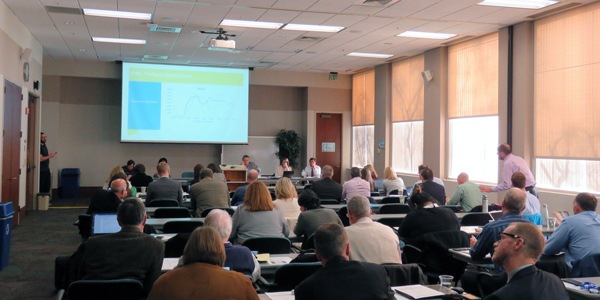By Jason Fordney
BOISE, Idaho — Integration into the Western Energy Imbalance Market (EIM) can present challenges for resources that don’t fit neatly into CAISO’s existing market model, market participants said during a regional conference Tuesday.

CAISO’s EIM Regional Issues Forum met on November 28 at Idaho Power headquarters in Boise | © RTO Insider
Speakers at the Nov. 28 Regional Issues Forum discussed their approach to effectively integrating hydropower, coal and jointly owned plants into the market. The group, which includes representatives from 10 sectors that gather to discuss various EIM topics, can produce opinions and other documents for CAISO, the EIM Governing Body or the ISO Board of Governors.

Le | © RTO Insider
Khai Le, senior vice president at generation supply management software developer PCI, told the forum that hydropower units are ideally suited to balance the variable output of renewables in the EIM, but could be much more effective with some operational changes to the market. Most EIM participants have a fairly rich mix of hydro and renewables, and “properly coordinated, that could be a very good marriage between the two,” Le said.
But hydro operators believe “there is lots of room for improvement in terms of hydro dispatch in the EIM market,” he said.
EIM hydro operators include PacifiCorp, Pacific Gas and Electric, Portland General Electric, Puget Sound Energy and Southern California Edison. Their hydro resources vary, and include pumped storage and “cascading hydro” systems in which the discharge from one hydro plant is used as intake for another. Seattle City Light will be the first EIM participant to offer 100% hydro resources when it joins the market in April 2019.
Modeling hydro resources can also be more difficult than other types of generation, Le said. Hydro owners cannot model their plants using CAISO’s “multi-stage generator” (MSG) model because some MSG parameters might only be updated one or two times a month, while hydro units have much more dynamic characteristics that require modeling on an hourly basis.
And while MSG allows for modeling of so-called “forbidden regions” — the different configurations, characteristics and overlapping regions that constrain the operations of many hydro resources — the CAISO system does not recognize cascading hydro and does not understand hydro topology and constraints, Le said.
Integrated properly, hydro operators will get more value in the EIM for the same output they had prior to joining the market, he said. Flexible capacity payments from the EIM are not sufficient for hydro operators to modify their operating rules for the market, he said, constituting just about 5% of the market’s revenue, which is mostly energy payments.
“The greatest challenge in operating your hydro resources is somehow trying to use your bid parameters to reflect the real-life hydro constraint that you have,” Le said.
Difficulties for Jointly Owned Units

Operating jointly owned units in the EIM can also be a challenge, according to Kelcey Brown, PacifiCorp manager of market and analytics. When it first joined the market, PacifiCorp modeled the full output of its jointly owned Jim Bridger plant but ran into problems with modeling schedules, ramping, heat rates and other issues.
“There were a lot of problems, actually,” she said. “We just could not get it right.” So in February 2016, the company began modeling only its share of the plant, which has made the situation much smoother, she said.
CAISO does not have the ability to model one unit as separate, individual units, she said, creating the need for PacifiCorp to modify the model to show its individual share of each unit. The company is exploring participation with its Hunter 1 and 2 coal units, which would require a similar approach.
Crossing the Rubicon

Clay MacArthur, vice president of power marketing at Utah-based Deseret Power Electric Cooperative, met resistance from plant operators and others when he proposed joining the EIM, which the company finally did in August. Deseret’s primary coal resource is the 500-MW Bonanza coal-fired plant, located in EIM member PacifiCorp’s balancing authority area.
“There was a pitchfork-and-torches moment when I announced to the coal plant, ‘Hey, I would like to take the plant into the EIM,’” MacArthur said. The company wanted to optimize its resource portfolio and improve reliability while gaining experience in organized markets.
“Everybody said ‘You’re insane, this is a huge mistake, you can’t do this,’” MacArthur said, because of worries about engineering and responding to the market. The co-op had to be careful to model the Bonanza units for the EIM in a way that would not destroy the unit, he said.
Co-op members visited a PacifiCorp coal plant that was already participating in the EIM and explored what he called “tribal knowledge” about transitioning into the market, which helped convince the doubters.

Regional Issues Forum participants: (Left-Right), Kelcey Brown, PacifiCorp; Clay MacArthur, Deseret; Zach Sanford, Navigant; RIF Chair Cameron Yourkowski, Renewable Northwest; Therese Hampton, PGP; Matt Lecar, PG&E.
The EIM does not require owners to completely turn over control of their plants, MacArthur said, but for Deseret, joining the market did involve plant upgrades, simplifying market modeling and using bidding strategies and operational expertise.
“We had to just kind of cross the Rubicon, and hope for the best.”



